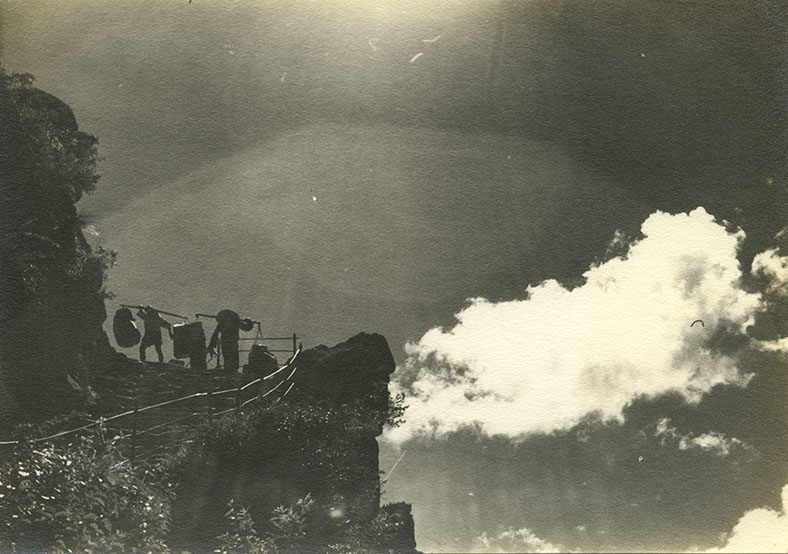
Zhang Yinquan
Trudging
1930s
Gelatin silver print
Zhang Yinquan started to practice traditional Chinese painting since his childhood and began to learn photography at 19. He was equally famous as another photographer Lang Jingshan. People called them “Lang in the South and Zhang in the North”.
Zhang Yinqun’s photography practice can be divided into three stages. The first stage was from 1919 to 1927 when he learned and proficiently mastered the photographic techniques. The second stage was from 1927 to 1937, the golden time for his creation. During this period, he travelled across China for beautiful landscapes. Later on Zhang became the photography assistant to Zhang Xueliang, this experience offered him more opportunities to take pictures. The third stage was after 1937 when he was engaged in photographic science research, writing theoretical works, and cultivating photographers for the newly-founded country.
Zhang Yinquan learned how to take pictures by reading photography books in English and conducted an in-depth research into this field. Besides, he had his own thoughts about the relation between photographic techniques and art. He said that techniques were rules while art was a skill. Rules should be followed by every photographer, such as focusing, exposure and photo development, while skills can truly show the photographer’s capability, such as composition, light, and expressions of figures and landscapes. Above rules and skills is a photographer’s concept of aesthetics. During his golden stage of creation, Zhang Yinquan experienced a change of photography aesthetics. Influenced by the traditional Chinese paintings, Zhang’s early pictures showed poetic and pictorial beauty. He said, “The art of photography is the reflection of one’s thoughts. It is the same with painting. Both of them should reveal your artistic conception.” The “painting” he referred means the traditional Chinese painting. And the artistic conception plays an important role in Chinese traditional aesthetic theories. It is an integration of aesthetic subject and object and the product of blending objective sceneries and the artist’s feelings. It brings the viewers into an oblivious state. Zhang pursued such the aesthetic effect by using photographic techniques and skills in his early stage. After the September 18th Incident in 1931, his concepts changed. He wrote in the foreword to volume 9 of Zhang Yinquan Photography Collections (not published), “My style changed somehow. Previously I pursued pure beauty and compositions that go with the content. But now, besides of beauty, I expect to show more strength. Perhaps the change is stimulated by the environment. At present the art that China needs is not about romantic themes. What we need is the spirit of fighting and overcoming difficulties. I hope to encourage myself with such spirit in photography.” From here we can see that an intellectual volunteered to help save his country with his art. In the 15th issue of Eagle Photography Magazine in March 1937, Zhang summarized his aesthetic features as “concise, bright, vivid and strong”.
A group of his photos displayed at the exhibition shows two kinds of Zhang’s aesthetic concepts. The four photos, Beneath the Banana Tree, Trudging, Drawing, Scenery of the Lake Reflected on the Curtain, obviously exhibit features of pure beauty, poetic charm and painting flavor. Whether it is about a laborer who carried a load and walked on a mountain path, or a young lady who rested her chin in her hands at a park, or the scenery profile through a hanging curtain, we can feel his pursuit of beauty. The four pictures show his excellent skills in light modeling. Especially in the picture 1930s no.90, the light effect, which enriches the space layers with clouds, rays, people and mountains, makes you want to touch it for its magnificent and vigorous aura. Turn the Tide, taken in 1935, represents his change to realistic themes and his pursuit of strength. The picture was taken on the river in Huanggang, Hubei Province in the summer. A wooden boat was sailing against the current in the Yangtze River, and the boatman wanted to grasp the swinging ropes. Zhang Yinquan seized the right moment. He thought that “that moment shows the boatman’s nervousness and the ropes’ movement.” It is a static picture but with strong dynamic energy. The boatman who leaned forward to grasp the ropes seems to have a power to touch our souls.
(Edited by Su Wenxiang, Xu Chongbao, Huang Si, 2015)

